 The $100 laptop project launched by MIT Media Lab, gained a big boost yesterday when the labs Nicholas Negroponte met with UN Secretary-General Kofi Annan at the World Summit on the Information Society in Tunisia.
The $100 laptop project launched by MIT Media Lab, gained a big boost yesterday when the labs Nicholas Negroponte met with UN Secretary-General Kofi Annan at the World Summit on the Information Society in Tunisia.
Kofi Annan opening address summed up the project and its hopes succinctly, “The true meaning of one laptop per child, is not a matter of just giving a laptop to a child, as if bestowing on them some magic charm. The magic lies within. Within each child there is a scientist, scholar, or just plain citizen in the making. This initiative is design to bring it forth into the light of day.”
No right thinking individual could possibly doubt the value of this project. There may be a lot of commercial concerns, but we’ll get to that later on.
The Specs
It will be Linux-based, full-colour laptop that uses a wind-up handle as a power source. Run at 500MHz, with 1GB of memory and a built in 1 Megapixel camera it should run most applications that could be required (remember Linux doesn’t suck up a lot of the processors power). Just the laptop screen alone is expected to cost around $35, pretty good when a screen on a laptop is normally $150 alone.
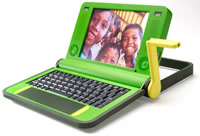 “USB ports galore” will be provided as will built-in WiFi. The only thing it will be missing is a hard drive. We’d imagine that this will be down to the additional power drain they have, and to try and maintain the necessary ruggedness. The networking will be via a wireless mesh.
“USB ports galore” will be provided as will built-in WiFi. The only thing it will be missing is a hard drive. We’d imagine that this will be down to the additional power drain they have, and to try and maintain the necessary ruggedness. The networking will be via a wireless mesh.
The driving theory of the project is that Learning is seamless – not just something that you do at school. This has lead to the need for an adaptable design, enabling it to be used as an electronic book (with the fingers at the back controlling the cursor), a games machine, TV set and, of course, laptop.
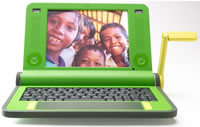 All software will be open source as in Negroponte view “open source software is the key to innovation in software and learning technology.”
All software will be open source as in Negroponte view “open source software is the key to innovation in software and learning technology.”
It’s been reported that Steve Jobs had offered Apple OSX for nothing for use in the project, but it was turned down as it wasn’t open source.
Availability and impact
The laptops will be financed though domestic resources (ie the countries government), donors, and what was rather mysteriously described as “other arrangements.” It will be at no cost to the recipients themselves.
The current plans call for producing five to ten million units near the start of late 2006 or early 2007, launching in six countries. Not bad considering that Negroponte first publicly announced it in January 2005. The promise is to bring the price down at each technical advance.
Negroponte spoke about “the same laptop being commercially available, at say $200” for small businesses. They hope to announce the construction partners soon.
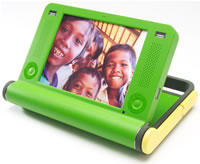 The impact of this project could be huge on many fronts – if it comes into being – and we’ve no reason to imagine that it won’t. Giving any and every child access to a computer, and teaching them to use it and inspiring them will be the start of a revolution bring free communication and equal learning to all citizens.
The impact of this project could be huge on many fronts – if it comes into being – and we’ve no reason to imagine that it won’t. Giving any and every child access to a computer, and teaching them to use it and inspiring them will be the start of a revolution bring free communication and equal learning to all citizens.
We don’t think that the impact will stop there. If the world is aware that there are laptops, perfectly able to carry out most daily required computing functions, that only cost $100, why would anyone want to pay for other ‘full price’ machines? The impact on the supply of hardware in the part of the world that already has computers will be huge.
All power to this project. Let’s help technology change the world for the better.
MIT Media Lab One Laptop Per Child
Watch the Launch video(Real video)
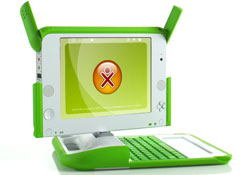 The One Laptop Per Child Foundation has focused its attention on the poorest kids in the United States, setting up a north American office and approaching state governments to get them interested in the cheapo laptop project.
The One Laptop Per Child Foundation has focused its attention on the poorest kids in the United States, setting up a north American office and approaching state governments to get them interested in the cheapo laptop project.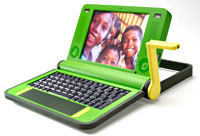 Yesterday, a spokesperson for the One Laptop Per Child (OLPC) programme revealed that Nigeria, Brazil, Argentina, and Thailand have all tendered commitments to purchase one million Linux laptops through the ambitious US-based programme.
Yesterday, a spokesperson for the One Laptop Per Child (OLPC) programme revealed that Nigeria, Brazil, Argentina, and Thailand have all tendered commitments to purchase one million Linux laptops through the ambitious US-based programme. This means that each laptop will be able to talk to its nearest neighbour and create ad hoc, local area networks for sharing data and connections.
This means that each laptop will be able to talk to its nearest neighbour and create ad hoc, local area networks for sharing data and connections.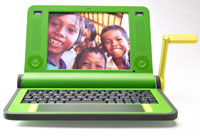 So far, AMD, eBay, Google, Nortel, Red Hat, and a number of other technology companies have all signed up to help support the project
So far, AMD, eBay, Google, Nortel, Red Hat, and a number of other technology companies have all signed up to help support the project The $100 laptop project launched by MIT Media Lab, gained a big boost yesterday when the labs Nicholas Negroponte met with UN Secretary-General Kofi Annan at the World Summit on the Information Society in Tunisia.
The $100 laptop project launched by MIT Media Lab, gained a big boost yesterday when the labs Nicholas Negroponte met with UN Secretary-General Kofi Annan at the World Summit on the Information Society in Tunisia. “USB ports galore” will be provided as will built-in WiFi. The only thing it will be missing is a hard drive. We’d imagine that this will be down to the additional power drain they have, and to try and maintain the necessary ruggedness. The networking will be via a wireless mesh.
“USB ports galore” will be provided as will built-in WiFi. The only thing it will be missing is a hard drive. We’d imagine that this will be down to the additional power drain they have, and to try and maintain the necessary ruggedness. The networking will be via a wireless mesh. All software will be open source as in Negroponte view “open source software is the key to innovation in software and learning technology.”
All software will be open source as in Negroponte view “open source software is the key to innovation in software and learning technology.” The impact of this project could be huge on many fronts – if it comes into being – and we’ve no reason to imagine that it won’t. Giving any and every child access to a computer, and teaching them to use it and inspiring them will be the start of a revolution bring free communication and equal learning to all citizens.
The impact of this project could be huge on many fronts – if it comes into being – and we’ve no reason to imagine that it won’t. Giving any and every child access to a computer, and teaching them to use it and inspiring them will be the start of a revolution bring free communication and equal learning to all citizens.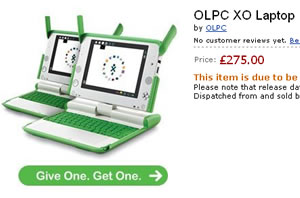 Europeans can now can legitimately order their own One Laptop Per Child (
Europeans can now can legitimately order their own One Laptop Per Child (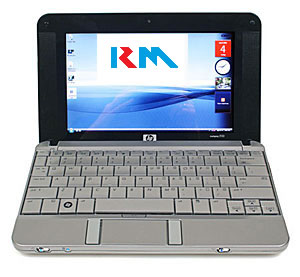 English computing stalwarts, RM announced that they have the exclusive contract to distribute new HP 2133 Mini-Note PC to schools, colleges and universities in the UK.
English computing stalwarts, RM announced that they have the exclusive contract to distribute new HP 2133 Mini-Note PC to schools, colleges and universities in the UK.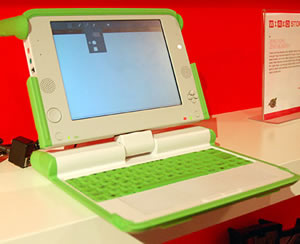 Well worth a visit in Manhattan, New York is tech magazine’s Wired’s “pop-up retail store” at 160 Wooster Street, SoHo.
Well worth a visit in Manhattan, New York is tech magazine’s Wired’s “pop-up retail store” at 160 Wooster Street, SoHo. Microsoft is hell bent on doubling the numbers of PCs on the planet by 2015, and is prepared to put its vast pots of money where its mouth is.
Microsoft is hell bent on doubling the numbers of PCs on the planet by 2015, and is prepared to put its vast pots of money where its mouth is. Microsoft’s bargain basement software sale opens opportunities for tie-ins with the
Microsoft’s bargain basement software sale opens opportunities for tie-ins with the 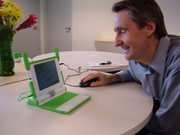 The One Laptop Per Child (OLPC) movement got a boost this week when their first production model arrived at their offices.
The One Laptop Per Child (OLPC) movement got a boost this week when their first production model arrived at their offices.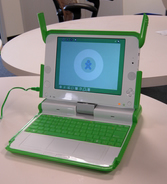 For us, the biggest surprise is the sheer smallness of it – when you see it sitting on top another ‘normal’ laptop it will be clear.
For us, the biggest surprise is the sheer smallness of it – when you see it sitting on top another ‘normal’ laptop it will be clear.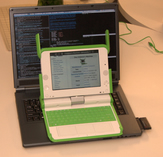 We’ve been avid followers of the OLPC or $100 laptop as it used to be called since the
We’ve been avid followers of the OLPC or $100 laptop as it used to be called since the 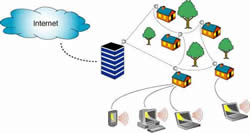 Mesh Networks are going to grow enormously by the end of the decade, according to ABI research. This ‘revalation’ is following years technical-types raving on about them.
Mesh Networks are going to grow enormously by the end of the decade, according to ABI research. This ‘revalation’ is following years technical-types raving on about them.